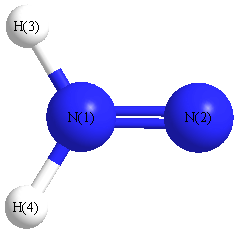Vibrational Frequencies calculated at SVWN/cc-pVTZ
| Mode Number |
Symmetry |
Frequency
(cm-1) |
Scaled Frequency
(cm-1) |
IR Intensities
(km mol-1) |
Raman Act
(Å4/u) |
Dep P |
Dep U |
|---|
| 1 |
A1 |
2797 |
2769 |
192.97 |
474.01 |
0.14 |
0.25 |
| 2 |
A1 |
1710 |
1694 |
59.63 |
48.49 |
0.18 |
0.30 |
| 3 |
A1 |
1642 |
1626 |
23.55 |
19.63 |
0.75 |
0.86 |
| 4 |
B1 |
1011 |
1001 |
77.82 |
5.73 |
0.75 |
0.86 |
| 5 |
B2 |
2639 |
2614 |
350.07 |
764.04 |
0.75 |
0.86 |
| 6 |
B2 |
1285 |
1273 |
10.53 |
32.82 |
0.75 |
0.86 |
Unscaled Zero Point Vibrational Energy (zpe) 5542.1 cm
-1
Scaled (by 0.9903) Zero Point Vibrational Energy (zpe) 5488.4 cm
-1
See section
III.C.1 List or set vibrational scaling factors
to change the scale factors used here.
See section
III.C.2
Calculate a vibrational scaling factor for a given set of molecules
to determine the least squares best scaling factor.
Charges, Dipole, Quadrupole and Polarizability
Charges from optimized geometry at SVWN/cc-pVTZ
Charges (e)
| Number |
Element |
Mulliken |
CHELPG |
AIM |
ESP |
| 1 |
N |
0.021 |
|
|
|
| 2 |
N |
-0.269 |
|
|
|
| 3 |
H |
0.124 |
|
|
|
| 4 |
H |
0.124 |
|
|
|
Electric dipole moments
Electric dipole components in Debye
(What's a Debye? See section
VII.A.3)
| |
x |
y |
z |
Total |
| |
0.000 |
0.000 |
-3.302 |
3.302 |
| CHELPG |
|
|
|
|
| AIM |
|
|
|
|
| ESP |
|
|
|
|
Electric Quadrupole moment
Quadrupole components in D Å
| Primitive |
|---|
| | x | y | z |
|---|
| x |
-12.019 |
0.000 |
0.000 |
| y |
0.000 |
-11.696 |
0.000 |
| z |
0.000 |
0.000 |
-12.654 |
|
| Traceless |
|---|
| | x | y | z |
|---|
| x |
0.156 |
0.000 |
0.000 |
| y |
0.000 |
0.640 |
0.000 |
| z |
0.000 |
0.000 |
-0.796 |
|
| Polar |
|---|
| 3z2-r2 | -1.592 |
|---|
| x2-y2 | -0.323 |
|---|
| xy | 0.000 |
|---|
| xz | 0.000 |
|---|
| yz | 0.000 |
|---|
|
Polarizabilities
Components of the polarizability tensor.
Units are
Å
3 (Angstrom cubed)
Change units.
| |
x |
y |
z |
| x |
1.452 |
0.000 |
0.000 |
| y |
0.000 |
2.695 |
0.000 |
| z |
0.000 |
0.000 |
4.035 |
<r2> (average value of r
2) Å
2
| <r2> |
16.662 |
| (<r2>)1/2 |
4.082 |
